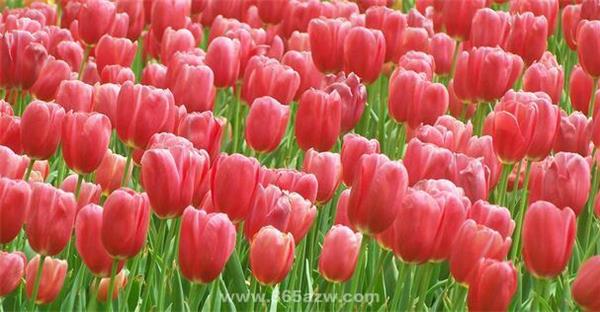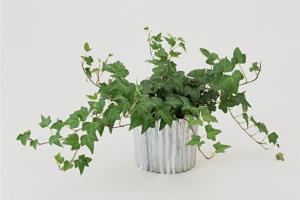Tulip breeding methods and precautions
Tulip is a relatively good breeding success of flowers, like flowers and grass care friends can start from tulip. Next, let's take a look at tulip farming methods.

Tulip breeding method
1. Upper basin
Generally take about 20cm pot diameter flowerpot cultivation, each pot can be shallow planting 3~5 balls, first cover the drain hole with two broken tiles, tile middle stack, each cover half. Then, cover the bottom of the pot with culture soil about 10cm thick. The culture soil is generally made of peat soil or raw soil mixed with fine sand in a ratio of 1:1. The culture soil should be replaced every year and continuous cropping is not allowed. Raw soil refers to soil below 30cm underground. Raw soil is used for planting to reduce pests and diseases. The top of the ball is flush with the earth. Remove the bulb skin, put the tulip bulb into the culture soil, gently press, and then add the culture soil to bury the bulb, the top of the bulb is flush with the soil surface. Gently compact the soil by hand. After the end of the basin, water immediately, a thorough irrigation, until the bottom of the basin has water seepage.
2. Rooting
At rooting stage after bulb planting, no light is needed, and the bulb is placed at 7℃~11℃ for shading treatment until its rooting (usually 4~6 weeks), otherwise it will affect the rooting of seed bulb and lead to blind flower bud or poor flowering quality. Keep the soil moist at this stage.
3. Growth

After 4 to 6 weeks, the plant can receive sufficient light to ensure that the plant receives no less than 8 hours of direct sunlight per day. If the light is not good, it is easy to grow, and the plant is thin and the leaves are yellow. The environmental temperature during the growth period is 15℃~18℃, which is suitable for the normal growth of tulips. At this stage, if the temperature is too low, it will delay the flowering time, and if it is too high, it will affect the flowering quality. The watering amount in the cultivation process should be appropriate, not planted in an excessively humid environment, otherwise it is easy to appear the medium moldy or bulb rot phenomenon, close to the flowering period, but also strictly control the watering amount. Tulips can be applied with thin cake fertilizer once every ten days or so, and some phosphorus and potassium fertilizers can be added properly before the bud is pregnant to bloom. 0.2% potassium dihydrogen phosphate solution can be applied 1~3 times to make the early flowering big. Tulip's growth and flowering, the nutrients it needs mainly come from the bulb, the formation of the bulb is more dependent on the nutrients in the soil, if the bulb is not planted in the second year, no fertilizer can also be used.
4, flowering
When tulips bloom, in order to prolong the flowering period, the following measures should be taken: (1) control the ambient temperature at 8℃~12℃. Because tulips like cool, flowers decay easily when the temperature is too high. (2) Keep the soil dry, water as little as possible, and do not spray water on the flowers when watering, otherwise the flowers will wither faster. (3) Keep the environment bright, but avoid too strong direct sunlight, strong light exposure flowers easy to decline. 4) Stop applying fertilizer.
5. Management after flowering

Tulips bloom in about three weeks. After flowering, the flowers can be discarded. If you want it to bloom again next year, you can use the following methods for conservation. After waiting for flower to wither, cut peduncle immediately, the bulb that takes a leaf is planted together inside basin (have small courtyard also can be planted on the ground). When planting, add base fertilizer first, preferably bean cake crumbs and bone meal, promote the growth of small bulbs, during which thin fertilizer is applied 2~3 times, usually watering is needed to prevent dryness. Tulips enter semi-dormancy in early summer, when bulbs must be dug out of pots and dried for storage. Refrigerate two months before planting, generally put in a refrigerator at 4℃~6℃. Wait until two months before the Spring Festival to re-pot, and apply base fertilizer. It will bloom again during the Spring Festival, but the flowers may be smaller.
It should also be reminded that the root system of tulip is most afraid of being hurt. Therefore, during or after the root formation of tulip bulb, it is forbidden to transplant tulip or move pots that may cause root injury. Once the root system is damaged, it will not bloom normally.
Tulip farming precautions
(1) In the middle and late April, most of the early-flowered varieties are close to the end of flowering, petals begin to wither, and the middle-flowered varieties enter the full flowering stage. When the temperature exceeds 28℃, the cut flower quality of most tulip varieties will be affected. The environmental temperature should be controlled at 10~20℃ to ensure the normal flowering of the plants. Too high temperature will make the plants appear dead buds. In early May, when the temperature was 20~25℃, the plants began to bear a large number of seeds. In late May, with the increase of temperature, the leaves began to wither and the regeneration bulbs gradually matured. At the beginning of June, the temperature is sometimes as high as 25~30℃, the root system gradually dies, the fruit turns from green to yellow, the capsule dehisces, the seed matures, and the bulb enters the dormancy stage.
How to raise tulips
(2) Tulip seeds germinate at low temperature. Generally, seeds begin to germinate at about 5℃, 7~9℃ is the best, and the germination rate is high. Germination is delayed above 16℃ and does not germinate above 25℃. Under suitable conditions, the germination rate is above 90%. If the seeds are refrigerated at 8~10℃ for 30 days before sowing, the seeds will germinate better. The optimum temperature for seedling growth is 13℃, and then controlled within 25℃.
(3) When tulip is cultivated in greenhouse in winter, the temperature and humidity of greenhouse are mainly regulated by ventilation, so as to keep the optimum temperature for stem and leaf growth and bud emergence and flowering. At the same time, during the bulb storage period, ventilation is also used to adjust the room temperature to reduce the chance of pest infection.
(4) Tulip flowerpot rotation, because the plant has phototaxis, to often rotate the flowerpot, so that the stem can grow upright and not inclined, the whole plant grows evenly, beautiful.
Tulip pest control.
The main diseases and insect pests of tulip are rot disease, sclerotium disease, virus disease, thrips, aphid and root lice.
Prevention and treatment of sweet silk blight.
Symptoms: whole plant withered, stem base entwined with white pigment or rapeseed brown sclerotinia, affected part browned and rotten. A large number of albinocins and tawny fungi can be seen on the soil surface.
Causes:
a. The fungus overwinters in the form of sclerotia or cordula left behind by the diseased body in the soil. When the conditions are suitable in the next year, the sclerotia cordula produces silk for initial infection.
b. The silk-like hyphae produced by the plant extend to contact adjacent plants or sclerotia are transmitted by water flow for reinfection, so that the disease spreads and spreads, and the continuous cropping or soil is sticky and the terrain is low or the year or season is serious.
Control method: Discovered diseased plants are removed and burned in time, diseased holes and adjacent plants are drenched with river water with 5% Jinggangmycin aqueous solution 1000~1600 times, or 50% Tian An aqueous solution 500~600 times, or 20% methyl chlorphos emulsion 1000 times, or 90% dixon wettable powder 500 times, and each plant (hole) is drenched with 0.4~0.5 liters. Combined with ploughing, 100~150 kg lime powder was added per mu to make the soil slightly alkalized and inhibit the propagation of white silk fungus.

The above is the tulip breeding method related introduction, like tulip friends can be used as a reference.
Keep the optimum temperature for stem growth and bud flowering indoors. At the same time, during the bulb storage period, ventilation is also used to adjust the room temperature to reduce the chance of pest infection.
(4) Tulip flowerpot rotation, because the plant has phototaxis, to often rotate the flowerpot, so that the stem can grow upright and not inclined, the whole plant grows evenly, beautiful.
Tulip pest control.
The main diseases and insect pests of tulip are rot disease, sclerotinia sclerotiorum, virus disease, thrips, aphid and root lice.
Prevention and treatment of sweet silk blight.
Symptoms: whole plant withered, stem base winding white pigment or rapeseed tea brown small sclerotia, affected part brown rot. A large number of albinocins and tawny fungi can be seen on the soil surface.
Causes:
a. The fungus overwinters in the form of sclerotia or cordula left behind by the diseased body in the soil. When the conditions are suitable in the next year, the sclerotia cordula produces silk for initial infection.
b. The silk-like hyphae produced by the plant extend to contact adjacent plants or sclerotia are transmitted by water flow for reinfection, so that the disease spreads and spreads, and the continuous cropping or soil is sticky and the terrain is low or the year or season is serious.
Control method: Discovered diseased plants are removed and burned in time, diseased holes and adjacent plants are drenched with river water with 5% Jinggangmycin aqueous solution 1000~1600 times, or 50% Tian An aqueous solution 500~600 times, or 20% methyl chlorphos emulsion 1000 times, or 90% dixon wettable powder 500 times, and each plant (hole) is drenched with 0.4~0.5 liters. Combined with ploughing, 100~150 kg lime powder was added per mu to make the soil slightly alkalized and inhibit the propagation of white silk fungus.

The above is the tulip breeding method related introduction, like tulip friends can be used as a reference.
Related
- Wuhan Hospital Iron Tree Blooming Result Was Instantly Frightened by the Gardener Master
- Which variety of camellia is the most fragrant and best? Which one do you like best?
- What is the small blue coat, the breeding methods and matters needing attention of the succulent plant
- Dormancy time and maintenance management of succulent plants during dormancy
- Minas succulent how to raise, Minas succulent plant pictures
- What are the varieties of winter succulent plants
- How to raise succulent plants in twelve rolls? let's take a look at some experience of breeding twelve rolls.
- Attention should be paid to water control for succulent plants during dormant period (winter and summer)
- Watering experience of twelve rolls of succulent plants
- Techniques for fertilizing succulent plants. An article will let you know how to fertilize succulent plants.



